
Imhotep was an Egyptian chancellor to the King Djoser, possible architect of Djoser's step pyramid, and high priest of the sun god Ra at Heliopolis. Very little is known of Imhotep as a historical figure, but in the 3,000 years following his death, he was gradually glorified and deified.

Memphis, or Men-nefer, was the ancient capital of Inebu-hedj, the first nome of Lower Egypt that was known as mḥw ("North"). Its ruins are located in the vicinity of the present-day village of Mit Rahina, in markaz (county) Badrashin, Giza, Egypt.
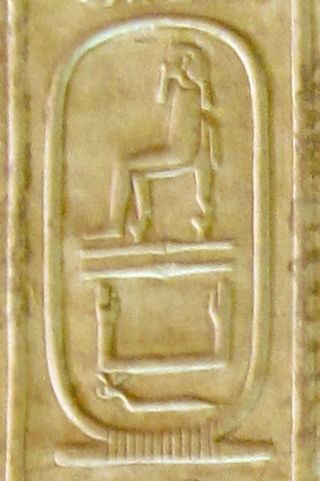
Shepseskaf was a pharaoh of ancient Egypt, the sixth and probably last ruler of the fourth dynasty during the Old Kingdom period. He reigned most probably for four but possibly up to seven years in the late 26th to mid-25th century BC.
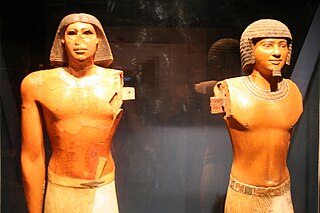
Ptahhotep, sometimes known as Ptahhotep I or Ptahhotpe, was an ancient Egyptian vizier during the late 25th century BC and early 24th century BC Fifth Dynasty of Egypt. He is credited with authoring The Maxims of Ptahhotep, an early piece of Egyptian "wisdom literature" or philosophy meant to instruct young men in appropriate behavior.
Merit-Ptah was thought to be a female chief physician of the pharaoh's court during the Second Dynasty of Egypt, c. 2700 BCE; she is purportedly referred as such on an inscription left on her grave at Saqqara by her son.
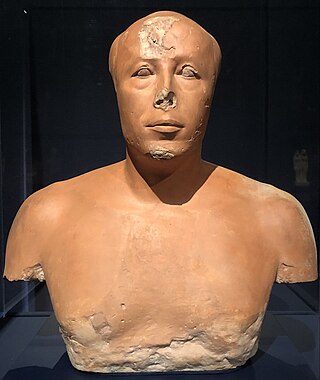
Ankhhaf was an Egyptian prince and served as an overseer during the reign of the Pharaoh Khufu, who is thought to have been Ankhhaf's half-brother. One of Ankhaf's titles is also as a vizier, but it is unknown under which pharaoh he would have held this title. He lived during Egypt's 4th Dynasty.

The following outline is provided as an overview of a topical guide to ancient Egypt:
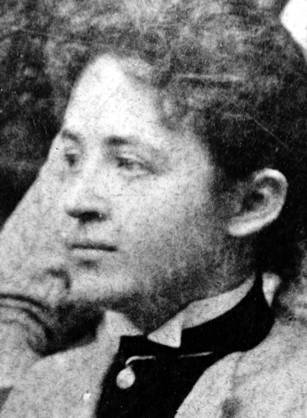
Kate Campbell Hurd-Mead was a pioneering feminist and obstetrician who promoted the role of women in medicine. She wrote A History of Women in Medicine: From the Earliest of Times to the Beginning of the Nineteenth Century in 1938. She was born in Danville, Quebec, Canada, and died in Haddam, Connecticut, United States.

Kanefer is the name of an ancient Egyptian prince. He lived during the 4th or early 5th Dynasty of the Old Kingdom period.

Khentkaus I, also referred to as Khentkawes, was a royal woman who lived in ancient Egypt during both the Fourth Dynasty and the Fifth Dynasty. She may have been a daughter of king Menkaure, the wife of both king Shepseskaf and king Userkaf, the mother of king Sahure.
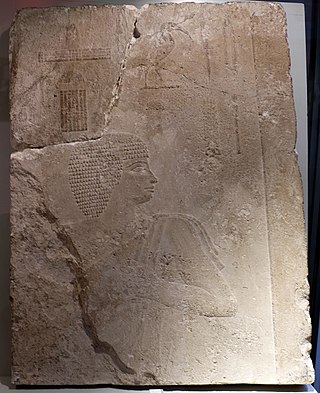
Meritites II or Meritites A was a 4th Dynasty princess of ancient Egypt, probably a daughter of King Khufu. She may have been a daughter of Meritites I based on the fact that this queen is mentioned in mastaba G 7650. She married the Director of the Palace, Akhethotep, and she had several children with her husband. Meritites and her husband shared a mastaba G 7650 in Giza.
Rekhetre was an ancient Egyptian queen from the late 4th Dynasty or early 5th Dynasty. She was a daughter of King Khafre. Her husband is never mentioned, but Rekhetre would have been the wife of one of Khafre's successors, possibly Menkaure.

Bunefer was an ancient Egyptian queen from the 4th or 5th dynasty. It is not known which king she was married to. Bunefer was buried in tomb G 8408 in the Central Field of the Giza Necropolis.
This page list topics related to ancient Egypt.

Psamtikseneb was an ancient Egyptian high official during the 26th Dynasty, perhaps under king Psamtik II.
Sekhem-ankh-Ptah was an ancient Egyptian high official who lived during the Old Kingdom period. His main title was that of a vizier, making him the most important official at the royal court, second only to the king. Other important titles of Sekhem-ankh-Ptah were "Overseer of all royal works" and "Overseer of the scribes of the king's document".
Akhethetep Hemi was an ancient Egyptian official at the end of the Fifth Dynasty, most likely in office under king Unas. His highest title was that of a vizier, making him the most important official at the royal court, only second to the king. Next to the vizier's titles he was also overseer of the treasuries, overseer of the scribes of the king's document and overseer of the double granary; all these were important positions at the royal court.
Medunefer was an ancient Egyptian eye-physician who lived in the Old Kingdom. Medunefer is only known from his mastaba excavated by Selim Hassan in Giza. This mastaba is a simple rectangular block with just a small inner chapel. The only decorated part that survived is a door lintel showing Medunefer sitting. There is also a short inscription listing Medunefer's titles. According to the text, he was king's acquaintance, master of the secrets of the palace, leader of the eye physicians of the palace and physician of the palace. There is not much else known about him. A more precise dating is not possible as of now.
Wahtye was a high-ranking priest and official who served under King Neferirkare Kakai during the Fifth Dynasty of Egypt. Based on his skull, he was probably around 35-years-old when he died.
Akhethetep was an ancient Egyptian official of the Old Kingdom, who is known from his burial at Giza, excavated in 1929–30 by the Egyptian Egyptologist Selim Hassan. Akhethetep had several rather modest titles, including ka-priest of the king's mother, scribe of the treasury or inspector of the scribes of the granary. He was also inspector of scribes at Akhet-Khufu. Akhet-Khufu is the pyramid of king Khufu. His wife was a woman called Nikauhathor. In his tomb are also mentioned on a false door a certain Kainefer and a woman called Peseshet. The latter, with the title overseer of the physicians, is perhaps the first female doctor known by name. The relationship of these two people to Akhethetep is unknown. Selim Hassan wonders whether they were his parents.











